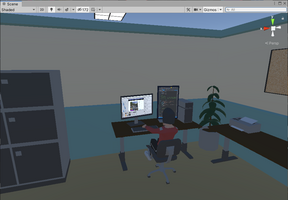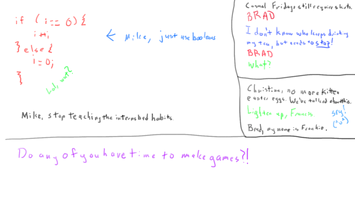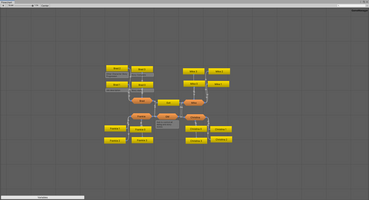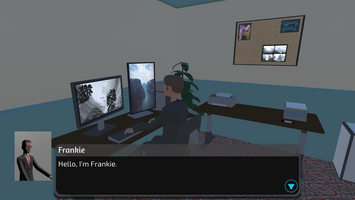Intern-ope - A Postmortem





Introduction:
I’m a game developer. This isn’t a difficult thing to say and be, so long as one makes games. However, I want to be a GOOD game developer. In order to do that, I need to understand more about why people play games. We don’t play games because we are so desperately in love with the mechanics that we can’t help but perform the activities presented to us. Certainly, there are some games where the action is the point, such as Dance Dance Revolution or Rock Star, but even then, our imagination is what turns the process into an experience. It’s about the story that we create in our heads, either of who we are when we dance or play guitar, or who we want to be when we take up a sword to slay the dragon or sneak into the mansion to steal the jewels.
I won’t go into the psychology of games or the biological impulses surrounding play here. I really just want to get to the heart of the importance of story in play. To that end, I made a short playable experience called, “Intern-ope.” I will provide a link for you to download and play it for free at the end of the article.
Creative Intent:
Surprisingly enough, I was inspired by the theme in a Twitter post. We were asked to use predictive text from our phones to fill in the blank prompted by: “I want to make a game about ___.” My phone came up with “the elephant in the room.” This was strange, because I don’t use that phrase in everyday speech, and I don’t often find myself in situations where it is applicable; in particular, I had never used it on my phone. Regardless, I immediately began having ideas about what that would look like, as a playable game.
I imagined an office, with several cubicles or work stations, all located along the periphery of a large, open room. I also imagined a sizable elephant in the middle of the room. The elephant would not do much, it would just get in the way. It would be constantly present, and its presence would be disruptive. I wanted the player, as the new intern, to be given duties to perform, all of which require interacting with coworkers in the office. During the performance of those duties, the player would have to navigate around the elephant.
Here’s the part that makes this game meaningful: no one will talk about the elephant. Any attempt to engage a coworker in a discussion about the elephant will be met with a range of responses, from ignorance to agitation, but there will be no resolution. In fact, the player will not ever come to understand what the elephant represents. The problem exists, but forget about solving the problem, the player won’t ever be able to identify the problem. It will just hang out in the room, getting in the way. I am not even mentioning the elephant anywhere in the game. Aside from this article, I will not mention the elephant anywhere else.
Production Methods:
This game is made in Unity, using Fungus to manage dialogue and interactions. I wrote my own first person controller following a tutorial I found online, because the one from standard assets is unmanageable. I incorporated some interaction between Unity’s 3D environment and the dialogue manager for fungus, and established a means to select dialogues based on which character I was interacting with.
Next, I established a flowchart for how dialogue would proceed. I have only done this a couple of times in games, and still need practice to ensure a smooth conversational style, as creating characters and giving them their own personalities requires a higher level of writing skill than I currently possess. Also, I did not want my dialogues to become boring or stale, despite my intention of having the game be a short play.
After ensuring that the game was playable and could reach a conclusion(?), I focused on establishing the ambiance of the room. I wanted this to be a stark office, full of administrative people performing their bureaucratic tasks in a mediocre way. Some motivational posters on the walls, and maybe a fake plant in the corner. This later changed to a game development studio, with more depth to the characters, and references to the development process. I also switched from motivational posters to de-motivational posters, to add levity.
Each cubicle would have some personal flavor. I wanted to have each character show some clues as to what might be going on, but nothing definitive. I want to imply things for the player, but never come right out and admit to what the elephant actually is. One guy might have an inappropriate calendar on his wall, while a woman might be disgusted by having to deal with him, and the only clue is a memo regarding how to file a workplace harassment complaint. Each cubicle would have a handful of little hints as to what the elephant is, but I want to leave it up to the player’s imagination. These character conflicts changed as I worked on developing the layout, and constructed personalities.
The elephant will follow the player around. I want the movement to be like Boo in Super Mario. He only moves when the player can’t see him. He will turn and face the player when on camera, but will only be a hindrance immediately after the player turns around. The elephant will also be contained to an area in the middle of the room. I’m not trying to trap the player anywhere, just create an annoyance.
What Went Right:
I found a great elephant model that was already textured and easy to import. I also found a wonderful set of snap-able walls and office furniture for help with creating an environment. There is also a free asset with office supplies and such, which helped with creating some flavor in the scene.
Creating character depth via environmental storytelling and through the use of flavor text was high on my list of wants. I incorporated imagery to tell stories about characters without forcing the player to read through dialogue text for it. By creating “personal spaces” for each character, I was able to give the player an idea about individual personalities, as well as hint at interpersonal conflict. I also used two white boards to create a means of communication between characters without having the player watch cut-scenes. By showing off how the characters maintained their spaces, I was able to convey more personality. By making the player an intern, I wanted them to have the feeling of stepping into a situation that was already awkward, and having no means of alleviating the tension.
I’m using a creative asset for character models that handily fit the visual style of the game. This saved me a bunch of time, as the models were easy to pose. I’ve really saved myself a lot of effort by using free assets, rather than modeling and texturing them all myself. I did make one model for the picture/cork-board/whiteboard frames.
What Went Wrong:
As with all things game development related, time and scope management was a concern. I’ve had enough practice now to mitigate these to a fair degree, but still ran into issues here and there. I did not manage to get everything in that I wanted, but I did get the necessary work done.
At the last minute, I realized that the elephant was not functioning according to plan. The day before the project was due, I rewrote the elephant script before finalizing the dialogue. This set me back a precious hour, but it was worth it.
Regarding dialogue, I would have liked to expand the scene to have 2–3 rounds of tasks and responses to the elephant inquiries. This is where the time management became a problem. I managed to get all of the flowchart boxes and variables to work how I wanted, but I was working on this right up to the last minute. As mentioned before, dialogue and character writing are not my forte, but I feel very good about what I have accomplished here.
Final Thoughts:
As game developers, we are also game players. Sometimes, we like to play with our audience, either by putting in Easter eggs, or secret rewards for obscure behaviors, and other such tricks. I wanted to play with my players on a psychological level. By creating a game which is not about what it appears to be on the surface, and not giving the player the satisfaction they want from their discovery, I am taking a little bit of enjoyment for myself. It’s not intended to be mean; it is a joke. No one wants to talk about the elephant in the room, and I hope that this game gets that point across.
Files
Get Intern-ope
Intern-ope
A short experience about being an intern at an indie game studio.
| Status | Released |
| Author | Zen of Thieves |
| Genre | Interactive Fiction |
| Tags | Narrative, Short |